Fed up with parched camping adventures? Longing to satisfy your thirst wherever you roam? Worry not, for I am here to impart a crucial skill: the method to replenish your camper’s fresh water tank! Master this technique, and the fear of depleting your water supply during your outdoor explorations will be a thing of the past.
In this article, I will guide you through each step of the process, ensuring that you have a comprehensive understanding of how to fill your fresh water tank. From preparing your water source to monitoring the fill level, I will leave no stone unturned.
But it doesn’t stop there! I will also share tips on maintaining a clean and fresh water supply, as well as how to properly empty and clean your fresh water tank after use. With my expert guidance, you’ll be well-equipped to keep your thirst at bay and enjoy your camping adventures to the fullest.
So, let’s dive in and unlock the secrets to a never-ending supply of fresh water for your camper!
Key Takeaways
- Locate the fresh water fill port on the camper and understand the tank’s capacity.
- Use a water pressure regulator and connect a hose to the fill port to prevent damage to the plumbing system.
- Sanitize the fresh water tank with a bleach solution before filling it completely with fresh water.
- Regularly inspect and clean the water system to maintain a clean and fresh water supply.
Prepare Your Water Source
Now it’s time for me to get my water source ready! When it comes to camping, conserving water is crucial.
Luckily, there are some tips I can share to help save water while enjoying the great outdoors. Firstly, I always make sure to have a few alternative water sources on hand. This includes bringing along a few jugs of water or investing in a portable water filtration system. These options not only provide me with a backup water supply but also allow me to fill up my fresh water tank without relying solely on campground water.
Additionally, I always carry a collapsible water container that I can use to collect water from natural sources like rivers or lakes. This way, I can minimize my impact on the environment and reduce my water usage.
Now that I have my water source prepped, it’s time to locate the fresh water fill port on my camper.
Locate the Fresh Water Fill Port on Your Camper
To easily refill your camper’s water supply, locate the port where you can add clean water. Did you know that a typical camper can hold up to 40 gallons of fresh water? It’s important to know the capacity of your fresh water tank so you can plan accordingly when filling it up.
Once you locate the fresh water fill port on your camper, you can begin the process of refilling your water supply. Finding the fresh water tank capacity is usually as simple as checking the owner’s manual or looking for a label near the fill port. This information will help you determine how much water you need to add and prevent overfilling.
Troubleshooting common issues with the fresh water fill port is essential to ensuring a smooth filling process. Some common issues include a clogged or stuck fill port, which can prevent water from flowing into the tank. In this case, you may need to clean or lubricate the fill port to resolve the problem.
Now that you know where to find the fresh water fill port and understand the capacity of your tank, you’re ready to move on to the next step: connecting the hose to the fill port.
Connect the Hose to the Fill Port
First, you’ll want to secure the hose to the designated port, ensuring a tight connection for a seamless water transfer experience. To make things easier, let’s discuss some ideas and important points to consider when connecting the hose to the fill port on your camper.
Using a water pressure regulator is crucial to protect your camper’s plumbing system from excessive pressure. This small device will help regulate the water flow and prevent any damage that could occur from high water pressure. It’s a simple yet effective tool that every camper owner should have.
Now, let’s talk about some common mistakes to avoid when filling the fresh water tank. One mistake is not using a water filter. Even though the water might seem clean, it can still contain impurities that could affect the taste and quality of your drinking water. Installing a filter will ensure that the water you fill your tank with is clean and safe to use.
Another mistake is overfilling the tank. It’s important to know your tank’s capacity and stop filling once it reaches that point. Overfilling can lead to leaks and damage to your camper’s water system.
With the hose securely connected to the fill port and the necessary precautions taken, you’re now ready to turn on the water source and start filling your fresh water tank.
Turn on the Water Source
Once you’ve securely connected the hose to the fill port, it’s time to flip the switch and let the water flow. But before you do, it’s crucial to understand the importance of using a water pressure regulator. This device helps regulate the water pressure coming from the source, preventing any damage to your camper’s fresh water system. Without it, high water pressure can lead to leaks, bursts, or even ruptures in the pipes.
Before filling the fresh water tank, it’s also essential to sanitize it properly. Start by draining any remaining water from the tank, then mix a solution of water and bleach. Use one-quarter cup of bleach for every 15 gallons of water your tank can hold. Pour this solution into the tank and fill it completely with fresh water. Let it sit for at least four hours, ensuring that the bleach solution reaches every nook and cranny of the tank. Afterward, drain the tank completely and flush it with fresh water until the bleach smell disappears.
Now that you understand the importance of water pressure regulation and have sanitized your fresh water tank, it’s time to monitor the fill level.
Monitor the Fill Level
As you keep an eye on the amount being poured, you gain a sense of control over the nourishment that will sustain your journey. Monitoring the fill level of your fresh water tank is crucial for a successful camping trip. Not only does it ensure you have enough water for drinking, cooking, and cleaning, but it also helps prevent water contamination.
Regularly checking the water tank level is important for several reasons. Firstly, it allows you to plan ahead and refill the tank before it runs out completely. Running out of water in the middle of your trip can be inconvenient and disrupt your plans. Secondly, monitoring the fill level helps you avoid overfilling the tank, which can lead to water spillage and wastage. Lastly, it allows you to detect any leaks or issues with the tank, preventing further damage and potential water loss.
To assist you in monitoring the fill level of your fresh water tank, I have created a simple table with three columns and three rows:
| Fill Level | Description | Action Required |
|---|---|---|
| Full | Tank is completely filled | No action needed |
| Half Full | Tank is halfway filled | Consider refilling soon |
| Low | Tank is almost empty | Refill as soon as possible |
By regularly checking the fill level and taking appropriate action, you can ensure a steady and reliable water supply throughout your camping trip. Now, let’s explore the next step: using a water filter, if desired, to further enhance the quality of your camper’s water supply.
Use a Water Filter, if Desired
Using a water filter, if you want to, can help purify and enhance the quality of the water supply for your camping adventure, like a refreshing oasis in the midst of nature. Not only does it provide clean drinking water, but it also removes impurities and unpleasant tastes, ensuring a more enjoyable camping experience. Here are four benefits of using a water filter:
-
Improved taste: A water filter eliminates any chlorine or other chemicals that may be present in the water, resulting in a fresher and more natural taste.
-
Healthier water: Filters can remove harmful contaminants such as bacteria, parasites, and heavy metals, making the water safer to consume.
-
Environmental friendliness: By using a water filter, you reduce the need for single-use plastic water bottles, helping to minimize waste and protect the environment.
-
Cost-effective: Investing in a water filter can save you money in the long run, as you won’t need to purchase bottled water or rely on expensive campground water sources.
While using a water filter is highly beneficial, there are alternatives available if you prefer not to use one. These alternatives include using water purification tablets, boiling water, or using a UV light sterilizer. These methods also help ensure the safety and quality of your water supply while camping.
Now, it’s time to disconnect the hose and secure the fill port for the next step in the process.
Disconnect the Hose and Secure the Fill Port
Disconnect the hose and make sure to secure the port to ensure a smooth transition to the next step in your camping setup.
Securing the fill port is an important task that shouldn’t be overlooked. When the hose is disconnected, it’s crucial to ensure that the fill port is tightly closed and secured. This will prevent any leaks or potential issues with the fill port, such as water spilling out or dirt getting inside.
To secure the fill port, you can use a cap or a screw-on lid specifically designed for your camper’s fresh water tank. These caps or lids are typically provided with the camper and are easy to use. Simply place the cap or lid over the fill port opening and twist it tightly until it’s firmly secured. This will create a watertight seal, ensuring that no water escapes from the tank during transportation or while camping.
Once the fill port is securely closed, you can move on to the next step of your camping setup: testing the water system. This will ensure that everything’s in proper working order and that you’ll have access to clean and fresh water during your camping trip.
Test the Water System
After disconnecting the hose and securing the fill port, it’s important to test the water system in your camper. This step is crucial to ensure that everything is functioning properly before hitting the road. Here are four key things to check during the test:
-
Water pressure: Turn on the faucet and check if the water comes out with adequate pressure. If it’s weak, there may be a clog or an issue with the pump.
-
Leaks: Carefully inspect all the connections and fixtures for any signs of leaks. Even a small leak can cause significant damage over time.
-
Water quality: Fill a glass with water from the faucet and examine its clarity and odor. If there are any abnormalities, it may indicate a problem with the filtration system or contamination in the tank.
-
Winterization: As the seasons change, it’s essential to know how to winterize your camper water system. This will protect it from freezing temperatures and prevent costly repairs in the future.
Now that we’ve tested the water system and ensured its proper functioning, it’s time to move on to the next step: emptying and cleaning the fresh water tank after use.
Empty and Clean the Fresh Water Tank After Use
To ensure the cleanliness and longevity of your camping equipment, it’s crucial that you properly empty and sanitize the tank used to store your drinking water. Cleaning techniques for the fresh water tank are essential in preventing water contamination.
After each use, it’s important to empty the tank completely. Start by draining all the water through the designated drain valve. This will remove any remaining water and debris from the tank.
Once the tank is empty, it’s time to clean and sanitize it. Prepare a solution of water and bleach, using a ratio of 1/4 cup of bleach for every 15 gallons of water the tank can hold. Fill the tank with this solution and let it sit for at least 30 minutes. This will allow the bleach to effectively kill any bacteria or contaminants in the tank.
After the designated time has passed, drain the bleach solution from the tank and thoroughly rinse it with clean water. Make sure to rinse it multiple times to remove any residual bleach. Once the tank is clean and free of any bleach smell, it’s ready to be filled with fresh water for your next camping trip.
Maintaining a clean and fresh water supply is essential for a successful camping experience. In the next section, I’ll provide you with some tips on how to achieve this and ensure that your drinking water remains safe and healthy.
Tips for Maintaining a Clean and Fresh Water Supply
After emptying and cleaning the fresh water tank in your camper, it’s crucial to maintain a clean and fresh water supply for your next adventure. Here are some tips I’ve learned from my own experiences on how to do just that.
-
Be mindful of water conservation: When camping, water is a precious resource. To conserve water, consider taking shorter showers, turning off the faucet when not in use, and reusing water when possible. This not only helps the environment but also ensures you have an ample supply throughout your trip.
-
Regularly inspect and clean your water system: Check for any leaks, cracks, or loose connections in your water system. Fixing these issues promptly will prevent water wastage and potential damage to your camper. Additionally, regularly cleaning your water system, including the tank, pipes, and faucets, will help maintain a fresh and hygienic water supply.
-
Troubleshoot common water supply issues: Sometimes, despite our best efforts, water supply issues can still occur. It’s important to be prepared and know how to troubleshoot common problems such as low water pressure, foul odor, or discolored water. Familiarize yourself with your camper’s manual and keep essential tools and spare parts handy to tackle these issues promptly.
By following these tips for water conservation and being proactive in troubleshooting common water supply issues, you can ensure a clean and fresh water supply for your camper, making your camping experience more enjoyable and hassle-free.
Frequently Asked Questions
How often should I fill my fresh water tank on my camper?
I typically fill my fresh water tank on my camper every 2-3 days to ensure a sufficient supply. However, it’s important to note that water conservation is key while camping. To conserve water, you can take shorter showers and turn off the tap when brushing your teeth. You can also reuse water when possible. Additionally, it’s crucial to properly disinfect your fresh water tank to maintain cleanliness. Use a mixture of bleach and water to thoroughly clean and disinfect the tank before each refill.
Can I use any type of hose to fill my fresh water tank?
Yes, you can use a garden hose to fill your fresh water tank on a camper. However, it’s important to ensure that the hose is clean and designated for potable water use. Using a water filter while filling the tank is a great idea to remove any impurities and improve the quality of the water. This will help keep your fresh water supply clean and safe for use during your camping trips.
How long does it typically take to fill a fresh water tank on a camper?
Typically, it takes around 10-15 minutes to fill a fresh water tank on a camper. However, the time may vary depending on factors such as water pressure and the size of the tank. To troubleshoot common issues with filling the tank, ensure that the water source has adequate pressure and that there aren’t any obstructions or leaks in the hose. Additionally, it’s important to properly sanitize the fresh water tank to prevent the growth of bacteria and ensure a clean water supply.
Do I need to use a specific type of water source to fill my fresh water tank?
You can use various water source options to fill your fresh water tank on a camper. The most common options are campground water hookups, water jugs, and portable water tanks.
Campground water hookups provide a convenient and continuous water supply, but they may not be available in all locations.
Water jugs are portable and can be filled from any water source, but they require manual filling and can be heavy to transport.
Portable water tanks offer a larger capacity and can be filled from any water source, but they take up more space and may require a pump for filling.
Are there any special precautions I should take when filling my fresh water tank on a camper?
When filling my fresh water tank on a camper, there are a few precautions I always take to ensure a smooth process.
First and foremost, I never use unfiltered water sources as they can introduce contaminants into the tank.
Additionally, I make sure to use a dedicated hose for filling and avoid using the same hose for other purposes.
Lastly, I always double-check the tank’s capacity and avoid overfilling, as this can lead to leaks and damage.
Taking these simple precautions can help avoid common mistakes and maintain a clean and functional fresh water tank.
Conclusion
In conclusion, filling the fresh water tank on your camper is a simple yet essential task for any camping adventure. By following the steps outlined in this article, you can ensure a clean and reliable water supply throughout your trip.
For example, let’s imagine a camping enthusiast named Sarah who followed these steps and successfully filled her fresh water tank. She was able to enjoy a refreshing shower and cook delicious meals using the water from her tank, making her camping experience even more enjoyable and convenient.
Remember to always maintain a clean and fresh water supply for a comfortable camping experience.










